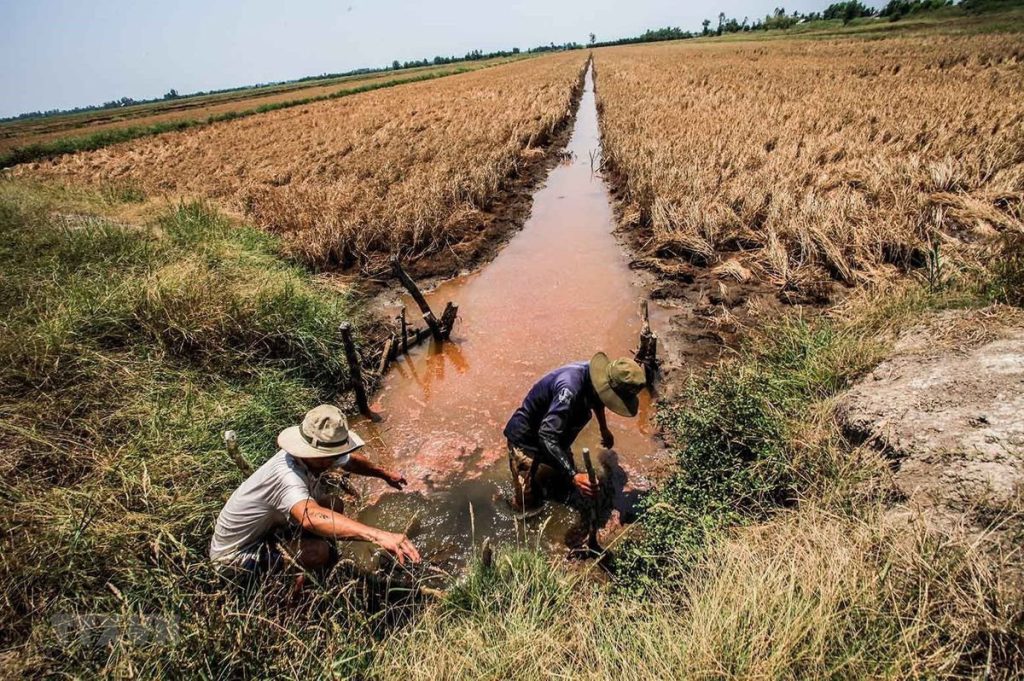Image source: https://btnmt.1cdn.vn/2022/02/11/121.jpg
1. Hydrological aspects
A coastal aquifer is surrounded at least from one end by a large body of salt water such as a salt marsh, sea, or ocean. Because of the direct hydraulic link between the freshwater in the aquifer and the former saltwater body, the aquifer is often threatened by saltwater intrusion and consequent deterioration of aquifer water quality.
The shape and extent of saltwater intrusion in coastal aquifers depend on several factors including the type of aquifer, its geology and structure; groundwater level or water pressure; sea water concentration and natural flow speed density; suction capacity and time or amount of water added; intensity and frequency of rain; evaporation rate; physical and geometrical characteristics of porous media; geometric and hydraulic boundaries; tidal effects; atmospheric pressure changes; Earth’s tides; earthquakes and other vibration effects; Water wave action and chemical changes. The depth of the coastal aquifer where saltwater infiltrates land ultimately affects the extent of infiltration.
2. The phenomenon of saltwater intrusion in Vietnam
Vietnam’s Mekong Delta is adversely affected by upstream hydropower development, local irrigation systems (dykes), climatic factors, and sea level rise. Hydrological changes are driven by a variety of causes with more immediate impacts of tidal systems and rising sea levels in the East Sea of Vietnam.
In 2016, the historic year of salinity caused 15 trillion VND (646 million USD) in damage to the delta. The Mekong Delta has a salt concentration of about 4 grams per liter, the Minister of Agriculture and Rural Development said at a meeting held Friday in Ben Tre province. The meeting chaired by the Deputy Prime Minister was organized to direct localities to prevent drought and saltwater intrusion during the dry season, ensuring agricultural production and livelihoods for local people. The phenomenon of saltwater intrusion in the dry season comes earlier than in previous years. Ministry data shows that saltwater intrusion has occurred since mid-December 2019 at Ham Luong estuary with a concentration of 4 grams/liter. Saltwater intrusion has covered 57 km from the river mouth, 17 km deeper than in 2016.
As usual, saltwater intrusion often occurs after the Lunar New Year. Calculations by the Vietnam Institute of Water Resources predict that saltwater intrusion on the Vam Co Dong River is up to 100km, about 40km deeper than the annual average and 3km deeper than in 2016. For the Vam Co Tay River, saltwater intrusion up to 110km, about 52km deeper. than the annual average and 5 km deeper than in 2016.
Saltwater intrusion will enter the Cai Lon River, reaching 70km, about 30km deeper than the annual average, and 5km deeper than in 2016. Will penetrate other local rivers in the delta, about 55-80km from the river mouth, about 23-49km. deeper than the average for many years and 3-7 km deeper than in 2016. Saltwater intrusion will affect 10 out of 13 provinces in the region. The Ministry predicts that about 136.00 hectares of fruit trees will be damaged, 158,000 households will lack clean water, especially 36,800 households in Ben Tre province, 32,400 households in Long An province, and 24,400 households in Soc Trang province. The Vice Chairman of Ben Tre Provincial People’s Committee said that the province has actively stored freshwater since mid-2019 and installed 46 salinity measurement stations to have a response plan.
3. Towards sustainable adaptation
The transboundary impacts of hydrological changes need to be included in long-term adaptation strategies in coastal areas. The choice to build sea dykes needs to urgently address important issues:
- How can equitable use of water and related resources in the Mekong be ensured?
- How can the costs and benefits of using Mekong River resources be negotiated between upstream and downstream countries?
- To what extent can salinity intrusion be addressed in the Mekong Delta?
To do this, there needs to be management coordination, adaptation as well as strategic development vision.
References:
Moving towards sustainable coastal adaptation: Analysis of hydrological drivers of saltwater intrusion in the Vietnamese Mekong Delta



 Tiếng Việt
Tiếng Việt 日本語
日本語